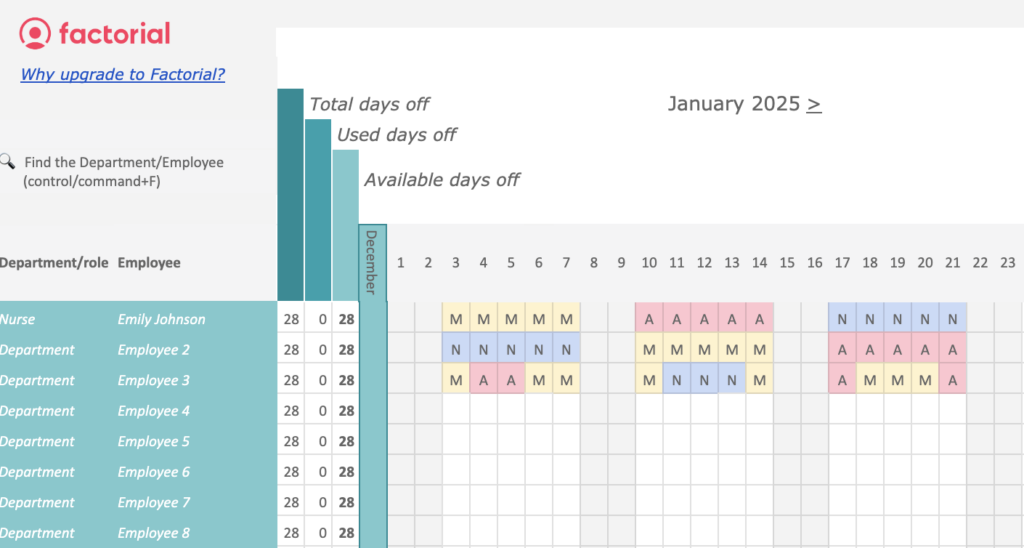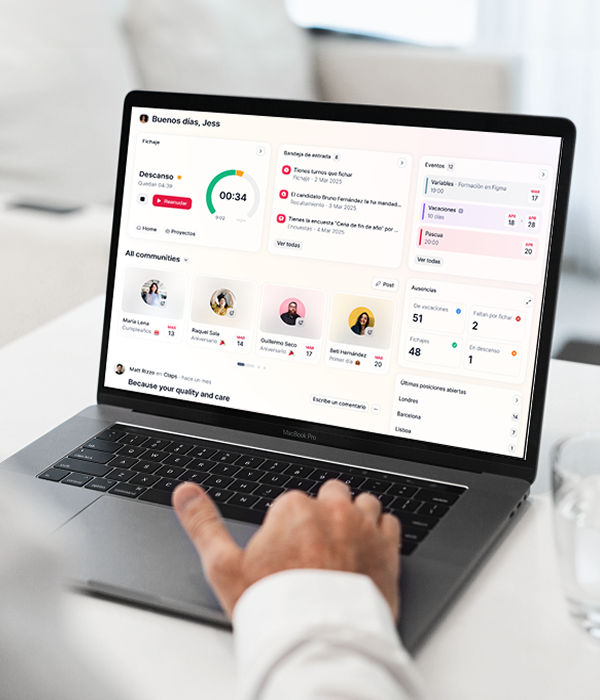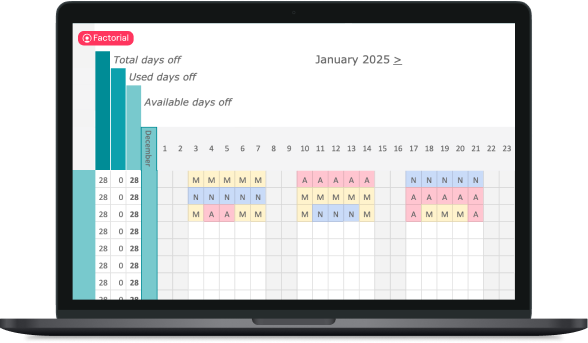Traditionally, work schedules were managed manually with pen and paper. However, these days it makes much more sense to use a daily or weekly employee schedule template to streamline your process.
In this post, we will share a step-by-step guide for creating your own employee schedule template in excel or Google Sheets. We will discuss the benefits of using Excel and share a free employee schedule template that you can customize according to the needs of your business.
What is an Employee Shift Schedule Template?
An employee shift schedule template serves as a crucial tool for organizations aiming to enhance operational efficiency and workforce management. Essentially, it is a digital or paper spreadsheet designed to assist in organizing and assigning shifts for employees. The primary objective is to establish a structured system that allows employees to be aware of their work schedules, fostering better communication and overall productivity within the organization.

📌 Want a free template? Download your employee shift schedule template now!
Key Benefits of Using an Employee Shift Schedule template
Using an employee schedule template can help you in more than one thing. It’s almost as good as HR software, in fact! Let’s take a look at a few of the advantages that come with the use of great shift schedules:
1. Organized Team Management
The template aids in structuring and organizing teams effectively, ensuring that workloads align with changing demands. This proactive approach enables smoother operations and enhances the overall workflow.
2. Enhanced Productivity
By providing a clear and transparent view of work schedules, employees can plan and manage their time efficiently. This, in turn, contributes to increased productivity as employees can focus on their tasks without uncertainty about their work hours.
3. Positive Employee Experience
Studies have demonstrated a strong correlation between positive employee experiences and engagement. An employee schedule template contributes to a positive work environment by offering clarity, reducing confusion, and facilitating a better work-life balance.
4. Improved Retention Rates
Employees who experience a positive work environment are more likely to stay with a company. The use of scheduling templates can significantly contribute to employee satisfaction, leading to higher retention rates. They are also eight times more likely to want to stay at a company, to be axact, according to McKinsey.
By implementing and adhering to an employee shift schedule template, organizations can cultivate a more organized, productive, and employee-friendly work environment.
Employee Schedule Template Instructions
An employee schedule template is a basic digital or paper spreadsheet that you can use to keep track of your employee hours. This helps you optimize your shift management process so that all your employees know in advance when they will be working.
You can design your own Excel or Google Sheets employee work schedule template to collect timekeeping information from your employees, or you can use downloadable employee schedule templates that are available online. You can then use the data contained in your templates to streamline your time management processes, calculate payroll, and monitor authorized and unauthorized absences. An employee scheduling template is also a great way to keep track of the efficiency and productivity of your teams.
Let’s start by looking at the steps involved in designing and sharing your own employee schedule template.
Create a blank spreadsheet
The first step in designing your own employee schedule template is creating a blank spreadsheet. You can do this using Excel, Google sheets, or any other spreadsheet software on your computer. Give your spreadsheet a relevant name so that you can easily locate it whenever you or your staff need it. For example, Employee Schedule Template [name of shift/department]
Insert column headings
The next step is inserting your column headers.
You should consider including columns for the following:
- Employee names (usually the first column) & ID numbers
- Workdays and/or dates (this will depend on whether you are creating a daily, weekly or monthly employee schedule template)
- Your business operating hours
- Your shift patterns
- Contact details of shift/departmental managers
- Employee working hours (or start and end times)
- Total hours worked during the defined period
- Comments or other relevant information
Add employee names
The next step is importing all your employee names into the first column. It’s a good idea to add these alphabetically so that your employees can easily find their names and consult their schedules.
Establish work schedules
Next, you need to add your work schedules to your employee schedule template. Include either the shift name or the specific hours that each employee is expected to work. Then count the total number of hours assigned to each employee and add it to the “Total Hours” column.
Save your employee schedule template
Once you’ve completed each employee schedule, save the spreadsheet as a new document with a different file name. That way, your original blank employee schedule template will be ready next time you need it.
For example, Employee schedule [name of team/department] [month]
Share your employee schedule template
And that’s it! All you need to do now is share your schedule so that all your workforce has easy access to it. You can share it digitally via email, post it on your intranet, and pin a hard copy onto your noticeboard if you have one. The more accessible it is, the easier it will be for your employees to consult their schedules as soon as you have released them, helping your company run more smoothly.
How to create an employee shift schedule template in Excel or Google Sheets
The most commonly used tool for creating an employee schedule template is Excel (or Google sheets). An Excel timesheet or schedule template makes your life easier as you can add as many rows and columns as you need, the software is user-friendly, and you can easily update the digital spreadsheet if your shift patterns change. You can also use a number of formulas to automate your template.
Let’s take a look at a couple of examples of what you can do using Excel or Google sheets. These will work well for you if your employees follow regular shift patterns and working arrangements are not too complicated.
Personal daily schedule
Just follow these steps to create your automated Excel employee schedule template. This schedule template is best for individual employee schedules (one template per employee).
Remember, this is just an example. You can customize any of the below steps to suit the needs of your business:
- Open Excel and start a new blank spreadsheet
- Select cells A1 to E2 and click “Merge and Center”
- Type “Weekly Schedule” into A1:E2
- Choose your font size and align
- Select cells F1 to H2 and choose borders from the “Borders” dropdown
- Add “Daily start time” into F1, “Time interval” into F2, and “Start date” into F3
- Select all cells and resize accordingly
- Add “Time” to cell A3, shift start time to cell A4, and the time interval to cell A5
- In cell B3, enter the first day you want to start the week with e.g. Monday
- Drag from the bottom right-hand corner of B3 to the right to continue the sequence
- Select row 3 and adjust the text accordingly
- Then select column A and adjust the text accordingly
- Center align all cells
- Use fill colors to highlight different schedules
- Save your schedule as a template
Weekly Work Schedule for a Team
And here’s an example of what you need to do to create a weekly employee schedule template for a team. This template works well if you prefer to keep all employee schedules within the same document. Again, you can adjust the design as needed.
- Open Excel and start a new blank spreadsheet
- Select cells A1 to E2 and click “Merge and Center”
- Type “Weekly Schedule” into A1:E2
- Choose your font size and align center
- Select cells F1 to H2 and choose borders from the “Borders” dropdown
- Enter the dates on the y-axis, and employee names on the x-axis, leaving a space between each name so that you can add positions
- Add employee hours and positions
- Use fill colors to customize each row to your preferences
- Save your schedule as a template
Types of Employee Schedule Templates
There are many different types of employee schedule templates. The right template for you will depend on your business needs and the needs of your employees. The most common types are daily, weekly, and monthly employee scheduling templates. Additionally, the right work schedule templates could also depend on your team’s projects, availability, and business model.
Let’s take a look at the biggest differences between them to help you decide which would work best for your scheduling needs.
Daily Employee Schedule Template
You can use a daily employee schedule template to manage shift patterns and calculate work hours and pay periods on a daily basis. These are best for tracking project activities and hours. You can also use this template as an employee calendar if you assign your employees to specific tasks during the working day and you want to specify break times (like a to-do list).
Weekly Employee Schedule Template
You can use a weekly timesheet if you prefer to calculate work hours and pay periods on a weekly basis. This template is best for contractors and part-time workers. It helps you avoid overtime and ensures that you don’t overschedule or underschedule your staff.
You can also use a weekly schedule template if your company uses a hybrid work schedule as it gives you and your remote employees a high-level overview of the entire week in advance so that you can plan accordingly.
Monthly Employee Schedule Template
Finally, you can use a monthly schedule template if you prefer to calculate work hours and pay periods on a monthly basis. These templates tend to be more detailed as they provide an overview of monthly hours and pay together with a weekly breakdown of data.
Employee Schedule Template Alternatives
If Excel isn’t your thing and you’d rather not play around with cells and formulas, you can keep track of shift rotation and calculate employee hours worked with a staff scheduling template. We’ve created a downloadable shift schedule template for you. This free template is fully customizable and can be easily adapted to the needs of your company. That way, managers can focus on developing their team and running an efficient business, rather than creating employee schedules manually.
Another great option that can make your life even easier is using shift scheduler software. Software solutions collect all the same data as a manual employee schedule template, but they offer a few extra perks.

For one thing, they streamline the process and ensure accuracy as there is less chance of human error. They give you a better overview of the entire company at a glance, and they help you ensure compliance with legal recordkeeping requirements. It’s also easier to identify trends or potential problem areas. And this, in turn, helps you become a more efficient and productive organization.
Create Employee Schedules with Factorial
If you like how templates make your work easier, you should definitely give HR software a try. Factorial, in particular, goes beyond the basics, offering seamless time tracking, PTO management, and dynamic shift scheduling that outshines traditional Excel templates. This user-friendly solution streamlines your tasks, acting like a helpful assistant for efficient workforce management.
👉 Book a demo with a product specialist and try Shift Scheduling software!
Utilizing software like Factorial can simplify your workload by automating the creation of recurring shifts and scheduling employees based on their availability. All of this work is done for you in just a few clicks, ultimately saving you valuable time and effort. Say farewell to manual headaches and embrace the modern, stress-free approach with Factorial!
FAQs about Employee Work Schedule Templates
Can excel generate a schedule?
Yes, Excel can generate schedules with templates. Moreover, with work schedule templates, managers will be able to customize them based on their team’s availability and business scheduling process.
What are some common scheduling challenges, and what can you do to prevent them?
The most common scheduling challenges include employee availability conflicts, shift swaps, and seasonality. One way to prevent these conflicts from occurring is by maintaining clear communication with your team and utilizing scheduling software to easily make adjustments and create staff schedules. Additionally, implementing a scheduling policy that outlines expectations and procedures will help align your staff and team communication.
What software is best for creating work schedules?
The best software to create staff schedules is Factorial. With Factorial’s shift management system, you can automatically create daily, weekly, and monthly shifts. The platform is integrated with AI capabilities and takes employee availabilities and time off requests into consideration.
Why is employee shift scheduling so important?
Making an employee schedule is crucial because it ensures smooth business operations, allows you to adequately meet business demands, and affects employee satisfaction. By properly scheduling staff during peak hours, you can uphold premium customer service while avoiding burnout and dissatisfied employees.



